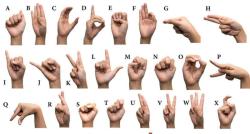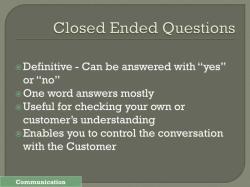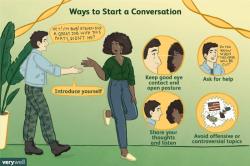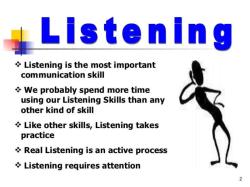What are some examples of effective listening?
Effective listening involves more than just hearing words; it encompasses various behaviors and actions that demonstrate genuine attentiveness and understanding. Here are some examples of effective listening behaviors:
1. Maintaining Eye Contact:
- Focused Attention: Making and maintaining eye contact shows interest and engagement in the conversation, signaling that you're actively listening.
2. Open Body Language:
- Facing the Speaker: Orienting your body towards the speaker demonstrates attentiveness and interest.
- Uncrossed Arms: Keeping arms uncrossed signals openness and receptiveness to the speaker's message.
3. Nodding and Other Encouraging Gestures:
- Nodding: Nodding occasionally shows agreement or acknowledgment of what the speaker is saying.
- Smiling and Expressive Facial Cues: Displaying positive facial expressions encourages the speaker and conveys understanding.
4. Minimal Verbal Encouragement:
- Active Listening Phrases: Using short verbal cues like "I see," "Go on," or "That makes sense" signals active engagement without interrupting the speaker.
5. Reflective Listening:
- Paraphrasing: Restating or summarizing what the speaker said shows that you're actively processing their message.
- Reflecting Feelings: Acknowledging the speaker's emotions by reflecting them back, such as saying, "It sounds like you're feeling frustrated."
6. Asking Clarifying Questions:
- Seeking Understanding: Asking open-ended questions or seeking clarification helps in understanding the speaker's perspective and shows interest in their thoughts.
7. Avoiding Interruptions:
- Letting the Speaker Finish: Refraining from interrupting allows the speaker to express themselves fully, ensuring you understand their message completely.
8. Empathy and Understanding:
- Empathizing: Showing empathy towards the speaker's feelings or situation demonstrates genuine care and understanding.
- Putting Aside Prejudgments: Avoiding assumptions or judgments allows for a more open and unbiased listening experience.
9. Remembering Details:
- Recalling Information: Demonstrating that you remember and recall details from previous conversations shows active listening and interest in the speaker's words.
10. Providing Feedback:
- Offering Constructive Feedback: Providing thoughtful feedback or responses after the speaker finishes can deepen the conversation and show your engagement.
11. Silencing Distractions:
- Minimizing Distractions: Turning off phones, closing laptops, or finding a quiet space helps in giving undivided attention to the speaker.
12. Being Patient and Attentive:
- Patience: Allowing the speaker to express thoughts at their own pace without rushing them fosters a comfortable and open environment.
Effective listening is about being present, engaged, and genuinely interested in understanding the speaker's message and feelings. Incorporating these behaviors can enhance communication and strengthen relationships.
Effective communication goes beyond simply exchanging words; it involves active listening, which is the ability to fully comprehend what another person is saying, both verbally and nonverbally. Active listeners demonstrate their attentiveness and understanding through various cues, fostering meaningful connections and enriching conversations.
- Nonverbal Cues:
Active listeners engage with their body language, conveying attentiveness and respect. They maintain eye contact, signaling their focus on the speaker's words. Nodding subtly acknowledges understanding and encourages the speaker to continue. These nonverbal cues create a sense of engagement and encourage the speaker to open up.
- Respecting the Speaker's Flow:
Active listeners allow the speaker to express themselves fully without interrupting. They refrain from jumping to conclusions or offering unsolicited advice. Instead, they wait patiently for the speaker to finish their thoughts, demonstrating respect for their perspective. This allows for a more coherent and meaningful exchange of ideas.
- Asking Insightful Questions:
Thoughtful questions are the hallmark of active listening. Active listeners engage their curiosity, posing questions that clarify points, seek deeper understanding, and explore different angles of the conversation. These questions demonstrate genuine interest and encourage the speaker to elaborate on their thoughts.
- Paraphrasing and Summarizing:
Active listeners demonstrate their comprehension by paraphrasing and summarizing key points. This involves rephrasing the speaker's words in your own understanding, ensuring that you have grasped the essence of their message. Summarizing the conversation at intervals helps solidify the main ideas and ensures that both parties are on the same page.
- Empathy and Understanding:
Active listeners create a supportive and encouraging environment by demonstrating empathy and understanding. They acknowledge the speaker's emotions, validate their feelings, and show genuine concern for their well-being. This approach fosters trust, openness, and a deeper connection between the listener and the speaker.












